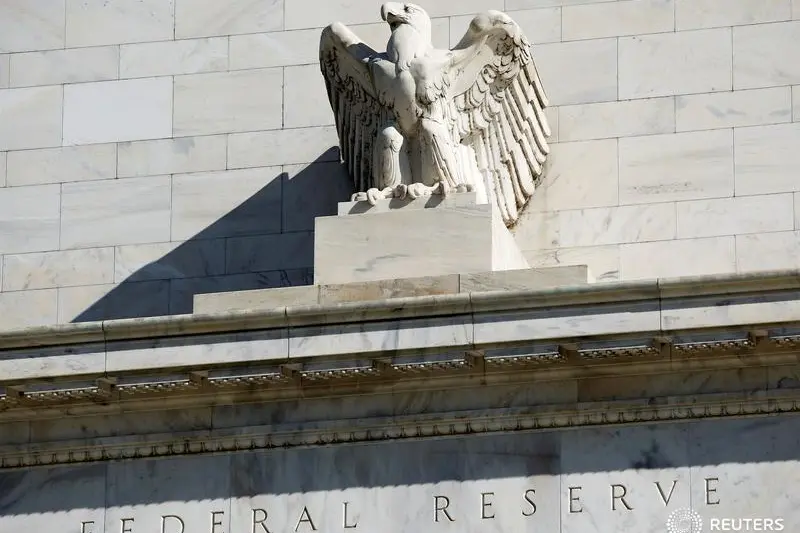PHOTO
The Federal Reserve Building stands in Washington April 3, 2012. REUTERS/Joshua Roberts/File Photo
ORLANDO, Florida - If post-pandemic inflation is a feature and not a bug - and the jury's still out on that - then the Federal Reserve may yet be tempted to lift its assumptions on where the 'neutral' long-term interest rate, the so-called 'R-star,' now lies.
Where Fed policymakers stand will become clearer at their June 13-14 policy meeting when they update economic forecasts, including their consensus view on the long-run policy rate - the equilibrium rate that neither stimulates nor slows the economy.
Just where that notional 'R-star' lies has been clouded by the wild supply-side distortions of the COVID-19 pandemic and last year's energy shock. But as something approaching normality hoves into view, the New York Fed has resumed publishing its quarterly estimates of the rate after a three-year hiatus.
The 'Laubach-Williams' model is one of the most closely-watched R-star forecasting tools, not least because one of its co-designers, John Williams, is currently the NY Fed boss and a prominent member of the U.S. central bank's policy-setting Federal Open Market Committee.
The latest estimate published on Friday shows R-star was 1.14% in the first quarter of the year, according to the 'L-W' model, barely changed from the 1.16% estimate for the preceding quarter.
It's a tricky one for investors to navigate, and not just because R-star is a theoretical rather than observable rate open to interpretation and constant revision.
The near-term pressure on interest rates from sticky inflation and a robust labor market appears to be upward, opening the possibility that rate-setters raise the policy rate even further this year and keep it 'higher for longer.'
If you believe that the post-pandemic world is one of deglobalization, reshoring, supply disruptions, energy refits and worker shortages, then structural inflation could well be higher than previously thought. And so will R-star.
That's the view of Deutsche Bank economists, who reckon R-star is closer to 1%. In a deep-dive report in February, they calculated that R-star estimates from a broad range of models and market-based signals have risen to around 100 basis points, from a historically low average around 50 basis points during the 2012-2019 period.
"The uniform upward movement in all R-star estimates provides some confidence that the neutral rate has risen from the historically low readings that prevailed before the pandemic," they wrote, while acknowledging the "substantial uncertainty" around these estimates.
They also noted that the margin for error in these estimates is so wide that, statistically, R-star may actually not be significantly different from zero.
NEGLIGIBLE PANDEMIC IMPACT?
If R-star is around 1% or higher, then the fear is that current policy may not be restrictive enough above that to rein in inflation, and will need to be tightened further. All else equal, this should raise yields across the maturity curve as short-term rates would likely rise over time.
Raising R-star from recent low levels would probably increase uncertainty in markets about its longer-term level and direction too. This would push up the 'term premium,' or compensation, investors demand for buying longer-dated bonds compared to continuously rolling over short-term ones.
On the other hand, if R-star is closer to zero, as Williams has suggested should be the case, current policy is too tight.
Policymakers' implied R-star estimate - derived from subtracting the Fed's 2% inflation goal from their median long-run federal funds rate forecast of 2.5% - has been stuck at 0.5% for the past four years, barring a short-lived dip to 0.4% in 2022.
Kevin Loane, head of U.S. analysis at Fathom Consulting, noted that policymakers have often gravitated towards the L-W model in times of divergence, rather than the other way around.
It's perhaps just as well for Fed officials that the model is now aligning with their view, but if the gap starts to widen again they might have a problem.
"Changing their estimate of R-star now would complicate their message. Indeed, changing estimates often would make communication a lot trickier," Loane said.
In a May 19 speech, Williams said there is "no evidence" that the era of very low natural rates of interest has ended and the impact of the pandemic on R-star appears "relatively modest".
Indeed, R-star is set to fall "slightly below zero," the New York Fed chief said, without giving a time frame. This suggests that the U.S. central bank's current policy rate target range of 5.00%-5.25% is already highly restrictive, and will soon need to come down.
A neutral rate below zero is not something investors are prepared for either, and would also present a significant communications challenge for the Fed.
(The opinions expressed here are those of the author, a columnist for Reuters.)
(By Jamie McGeever; Editing by Paul Simao)





















